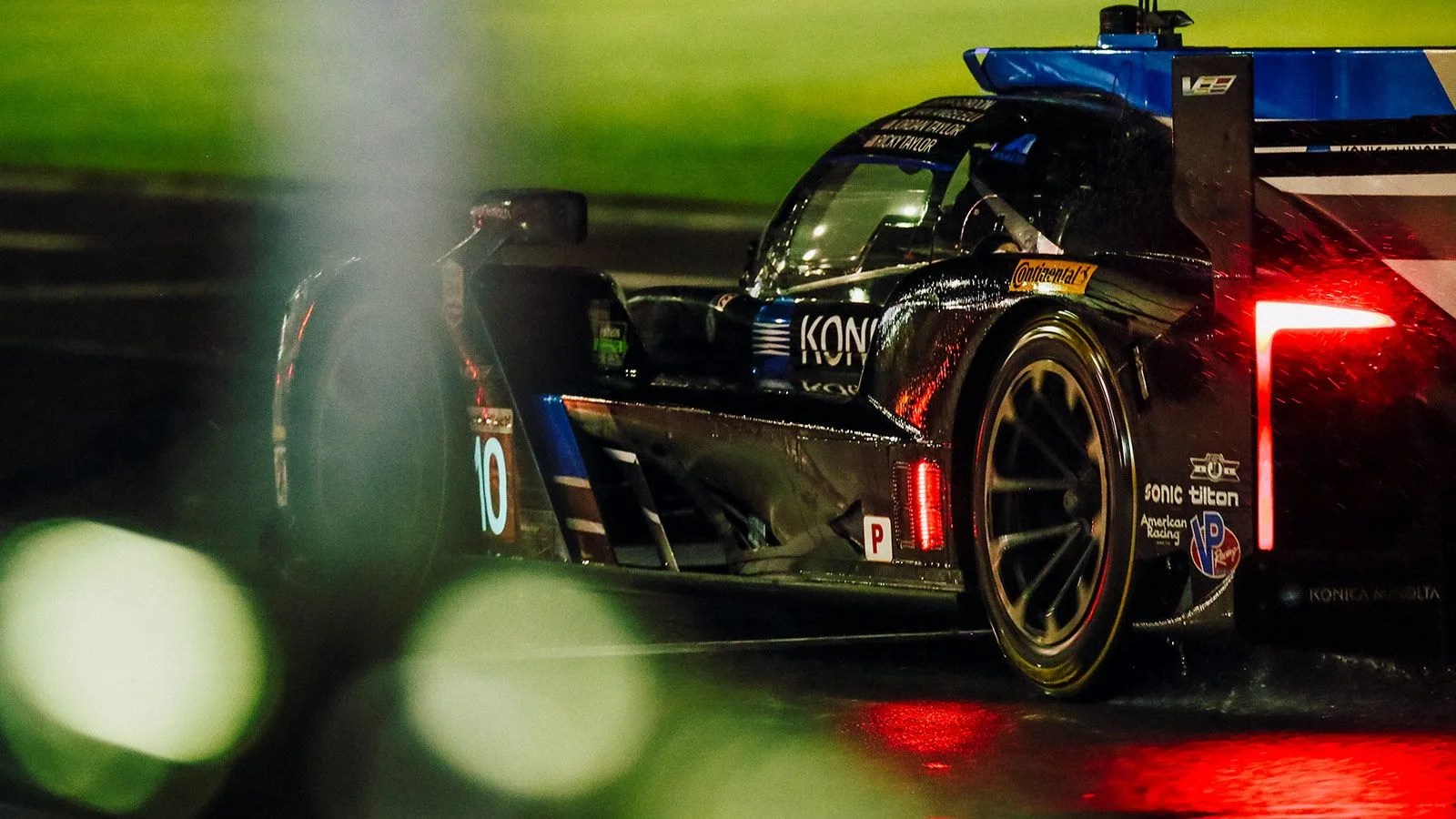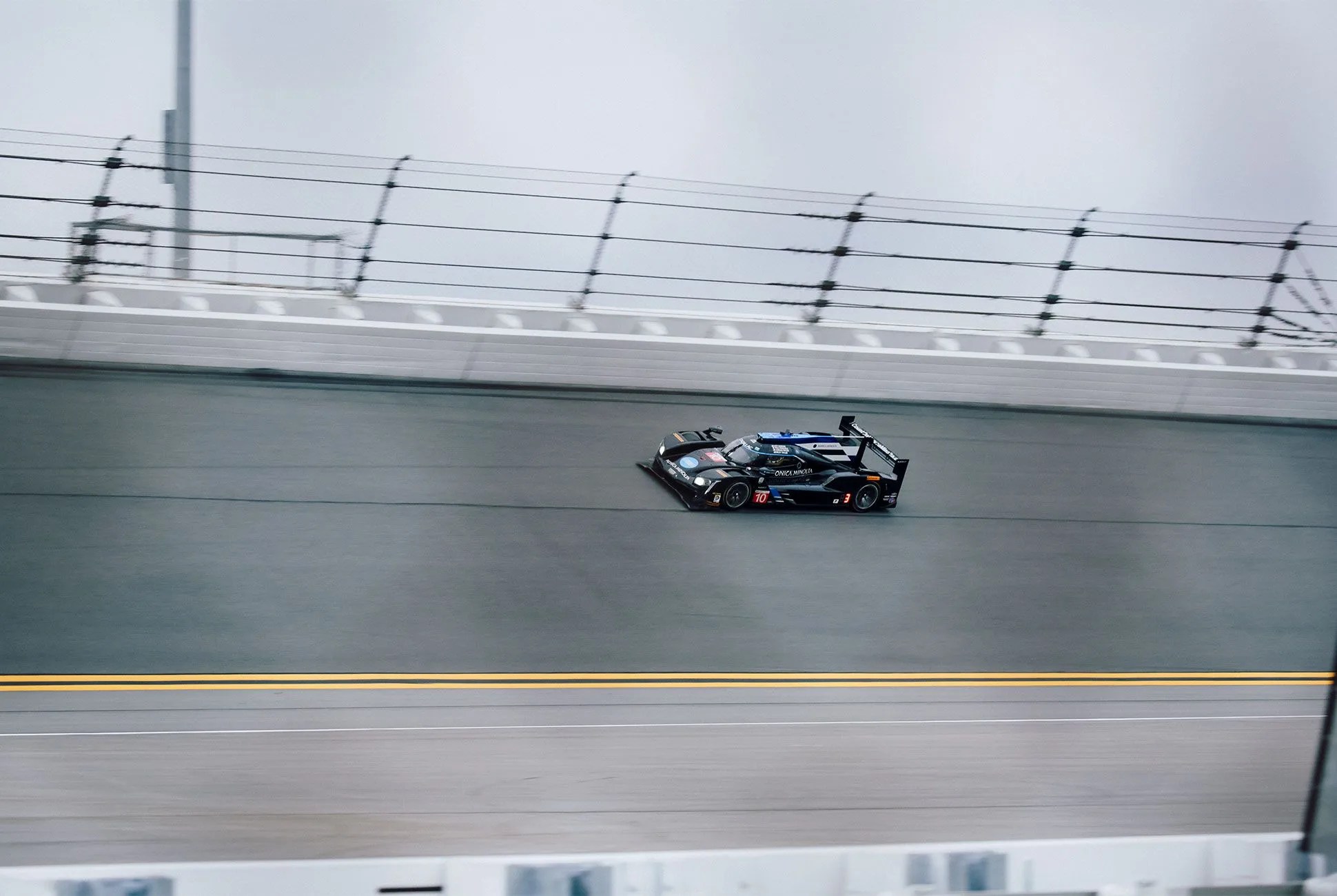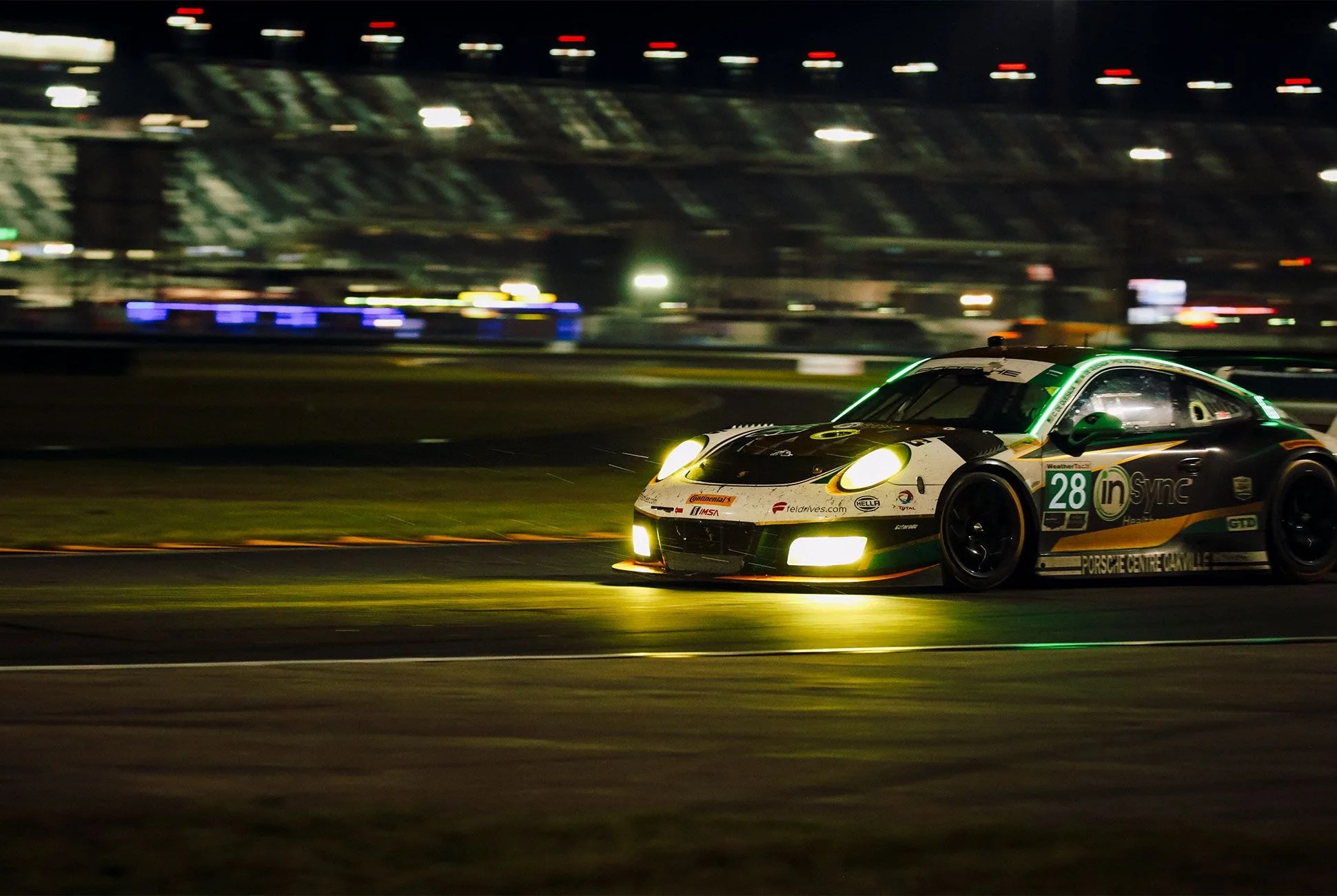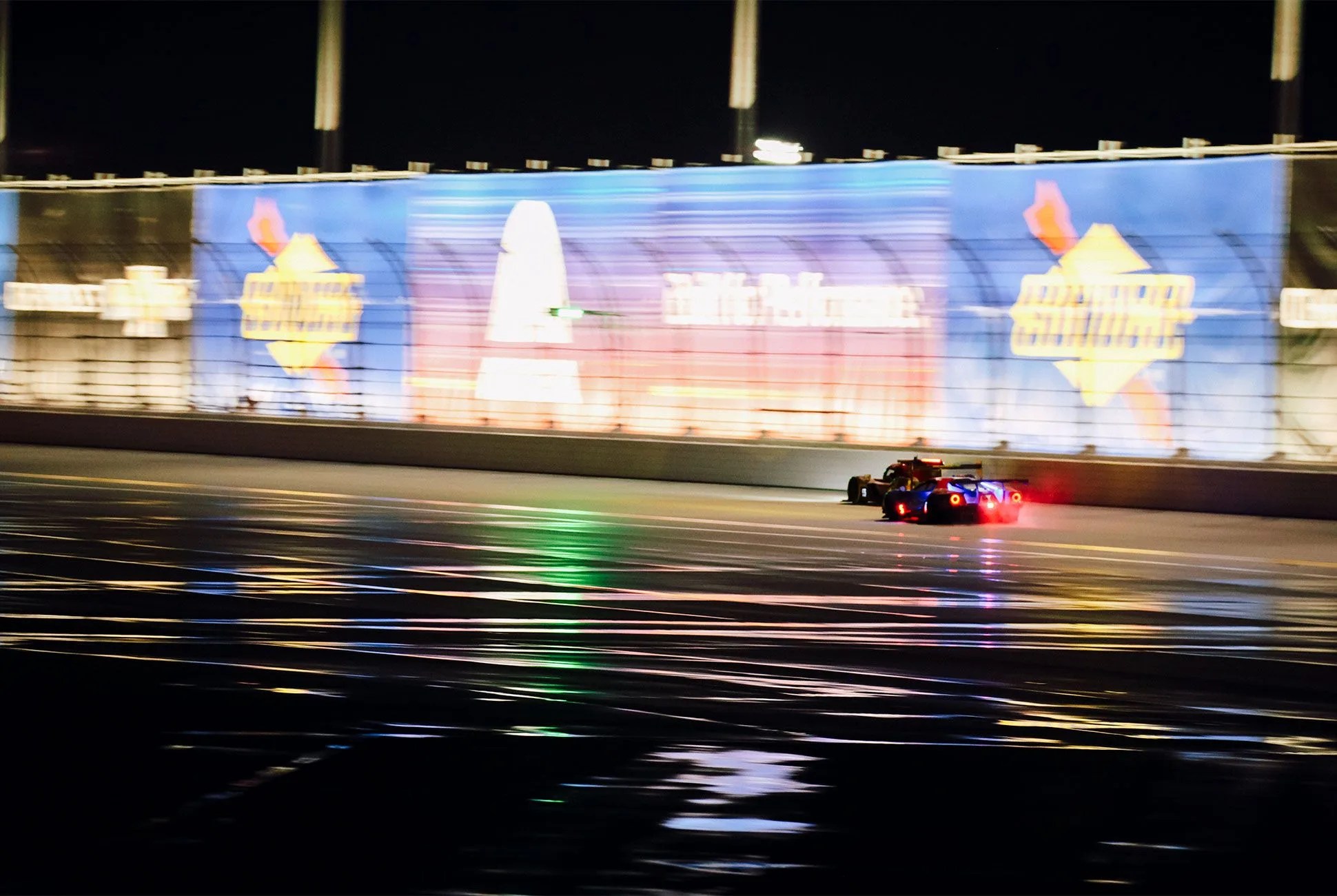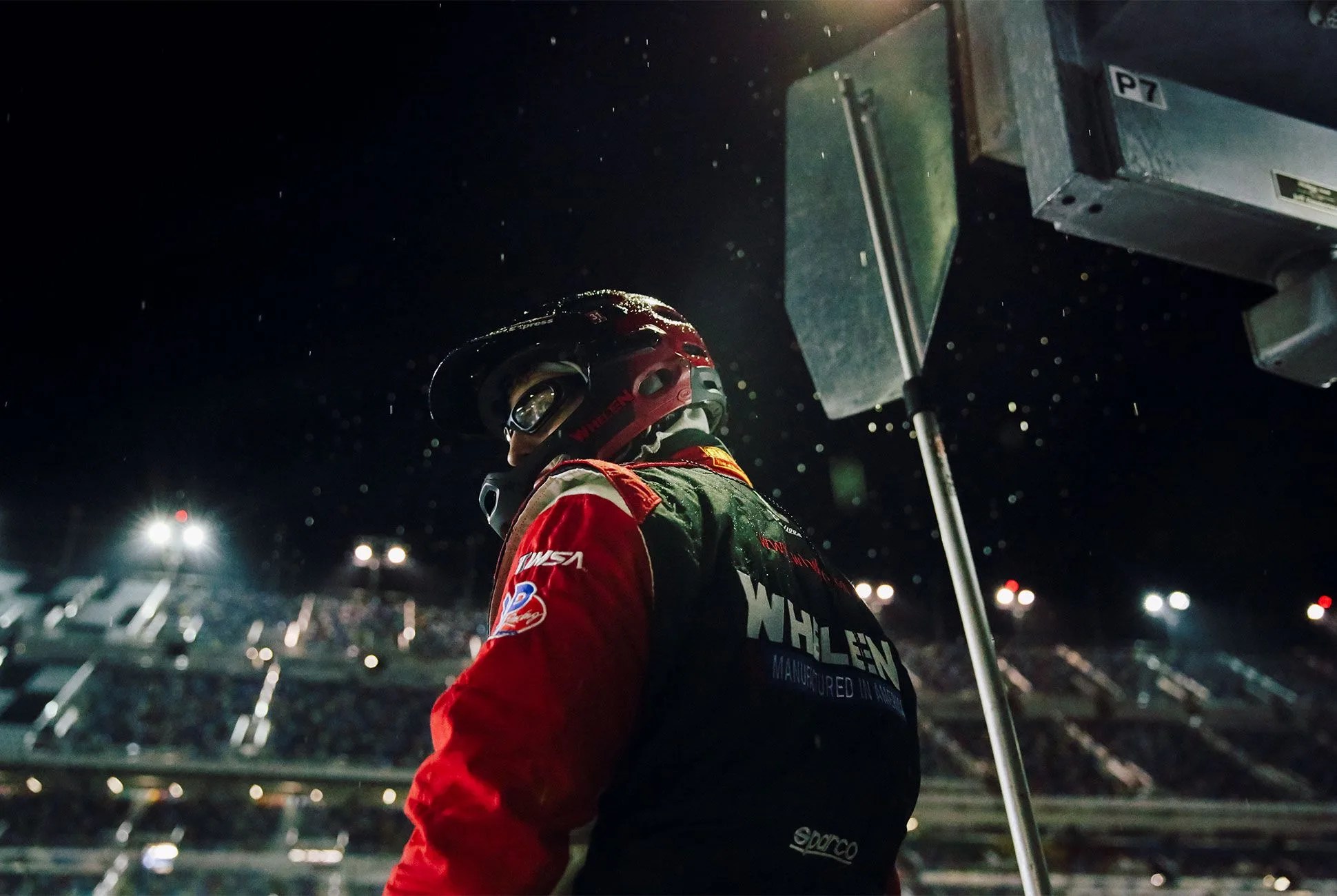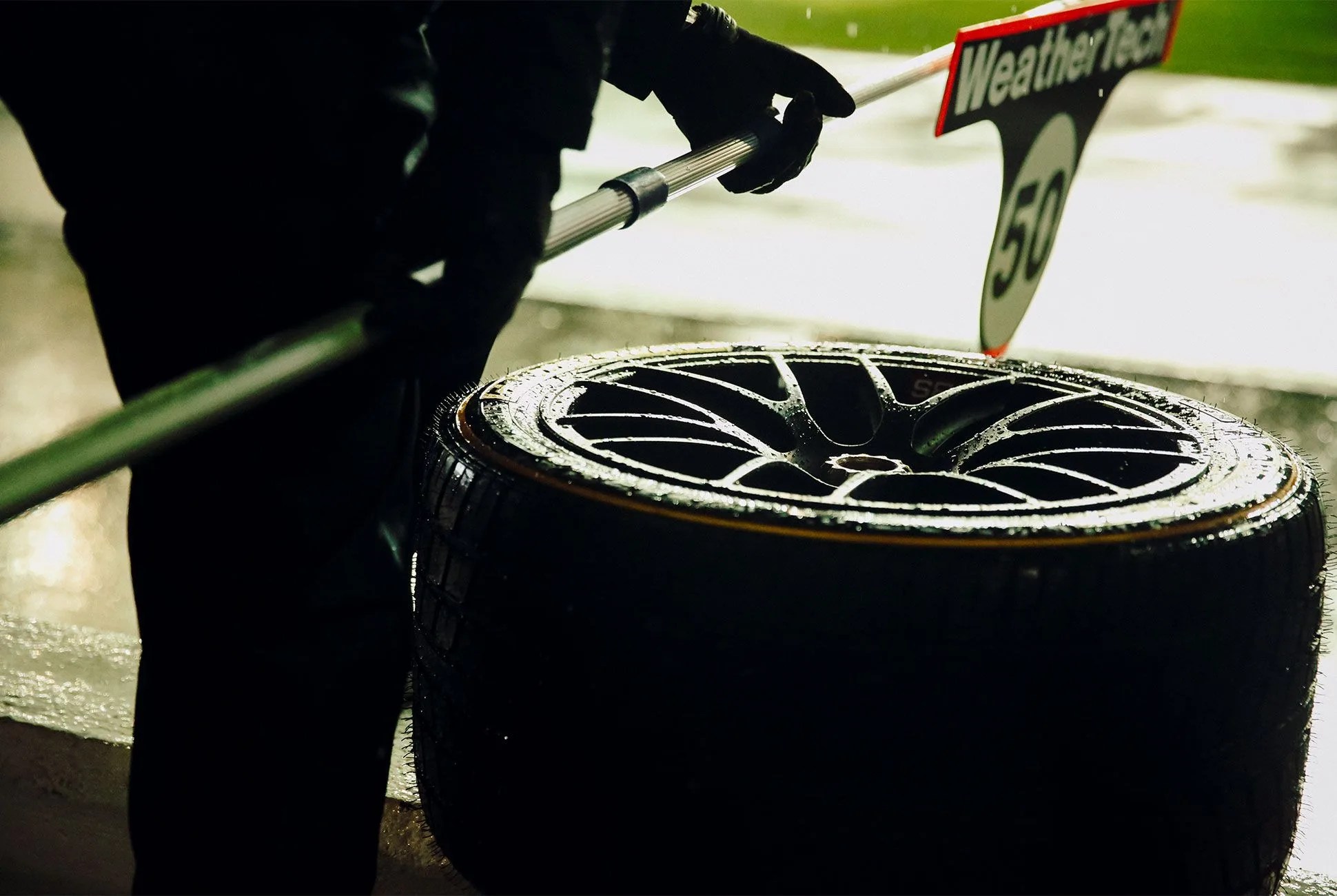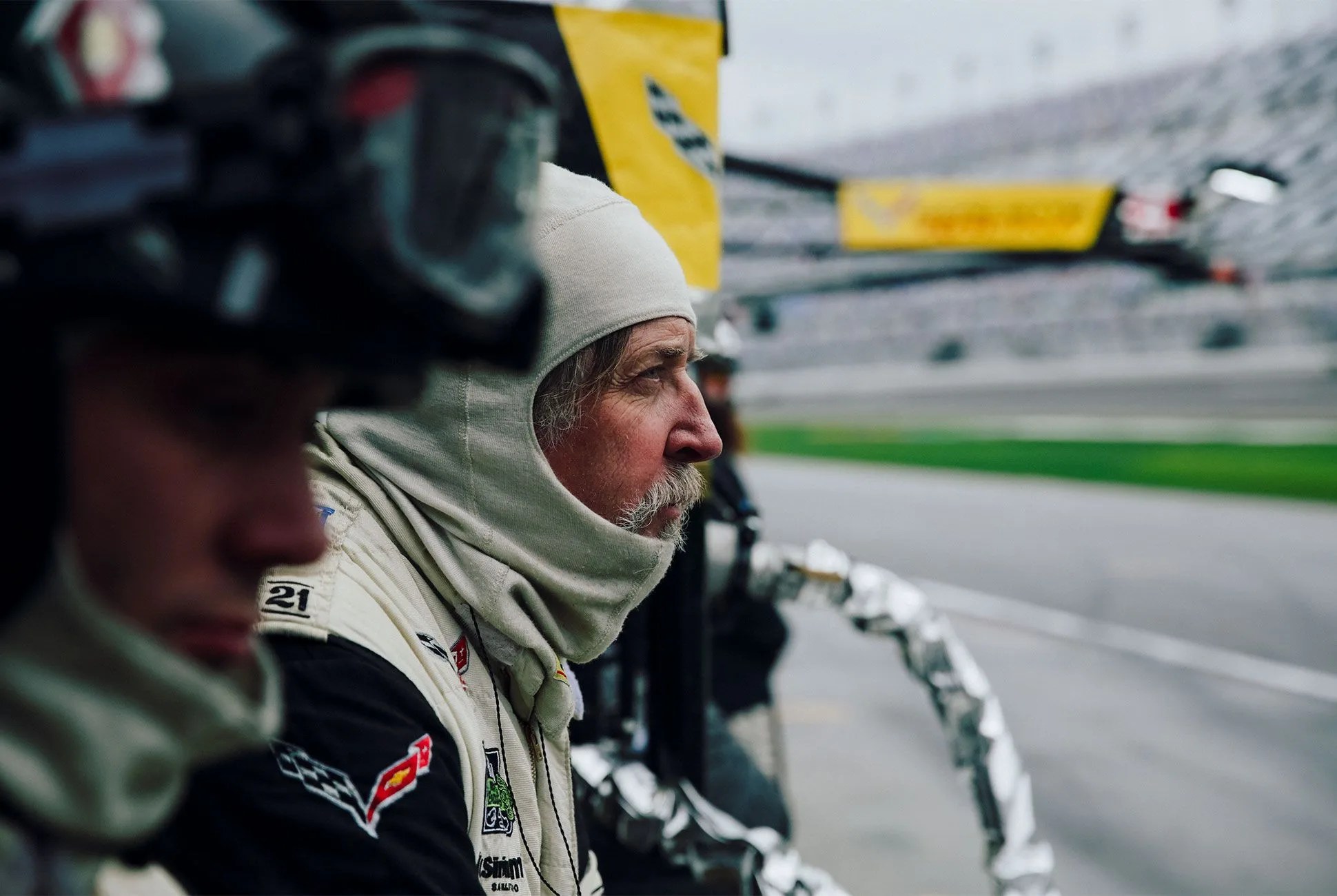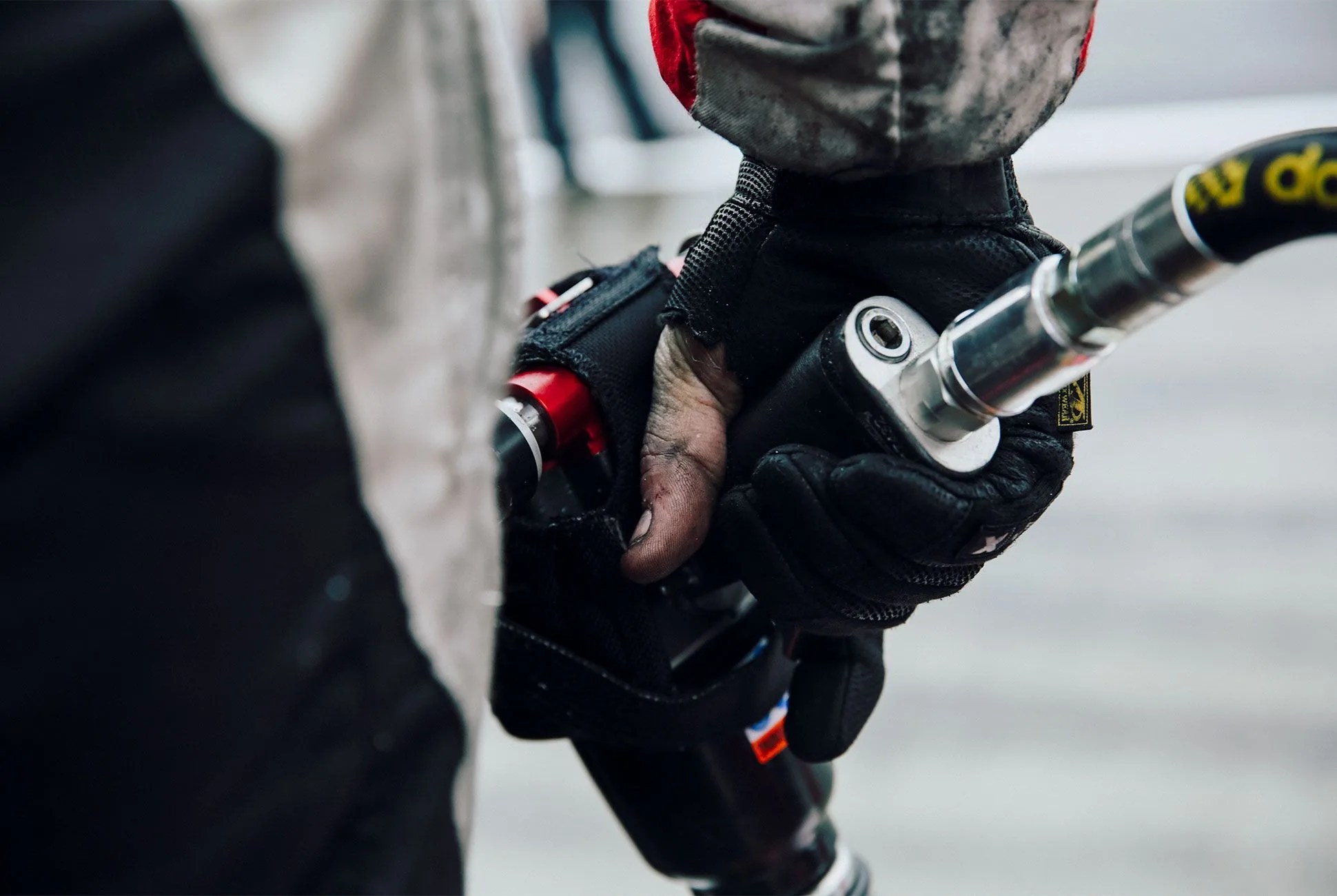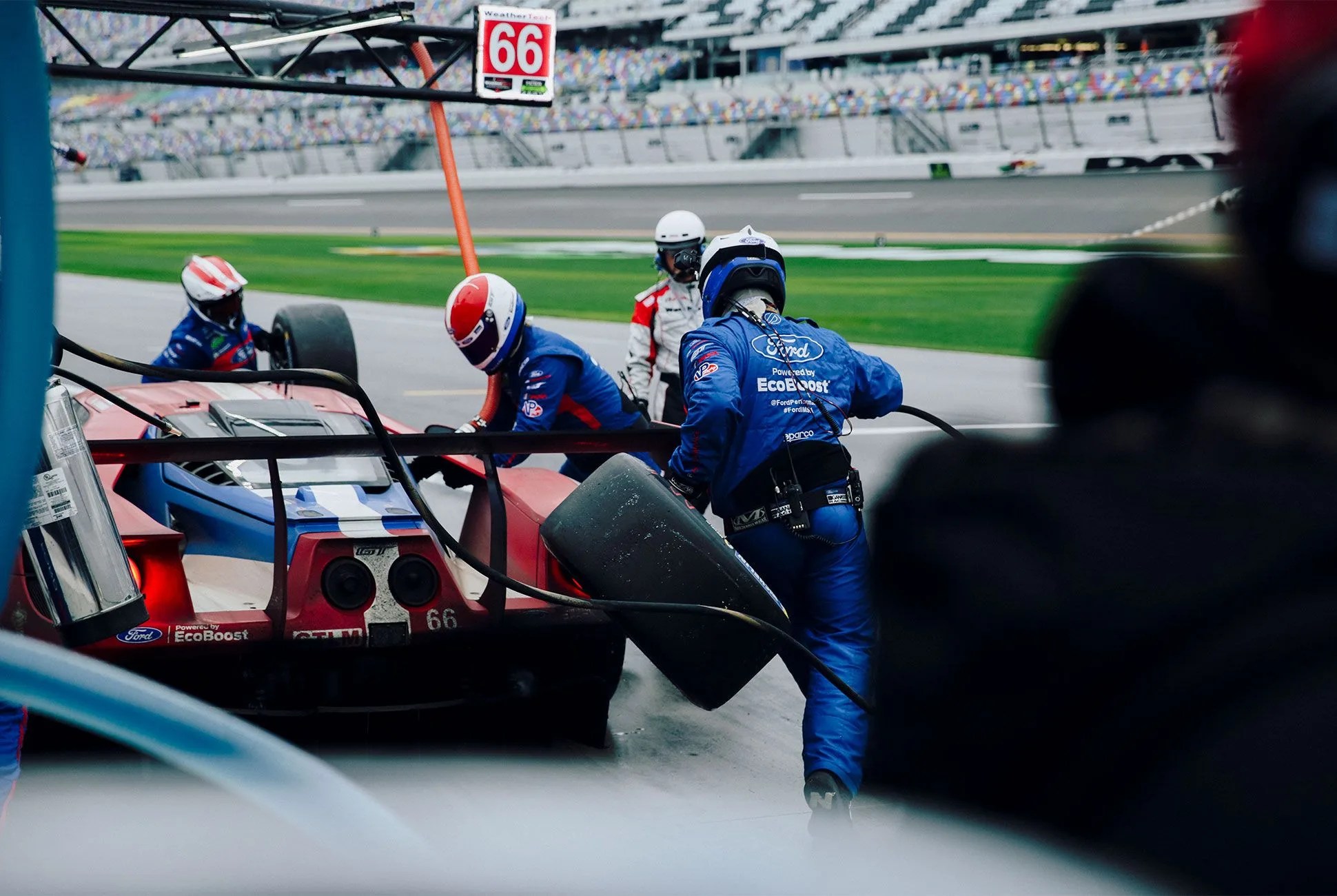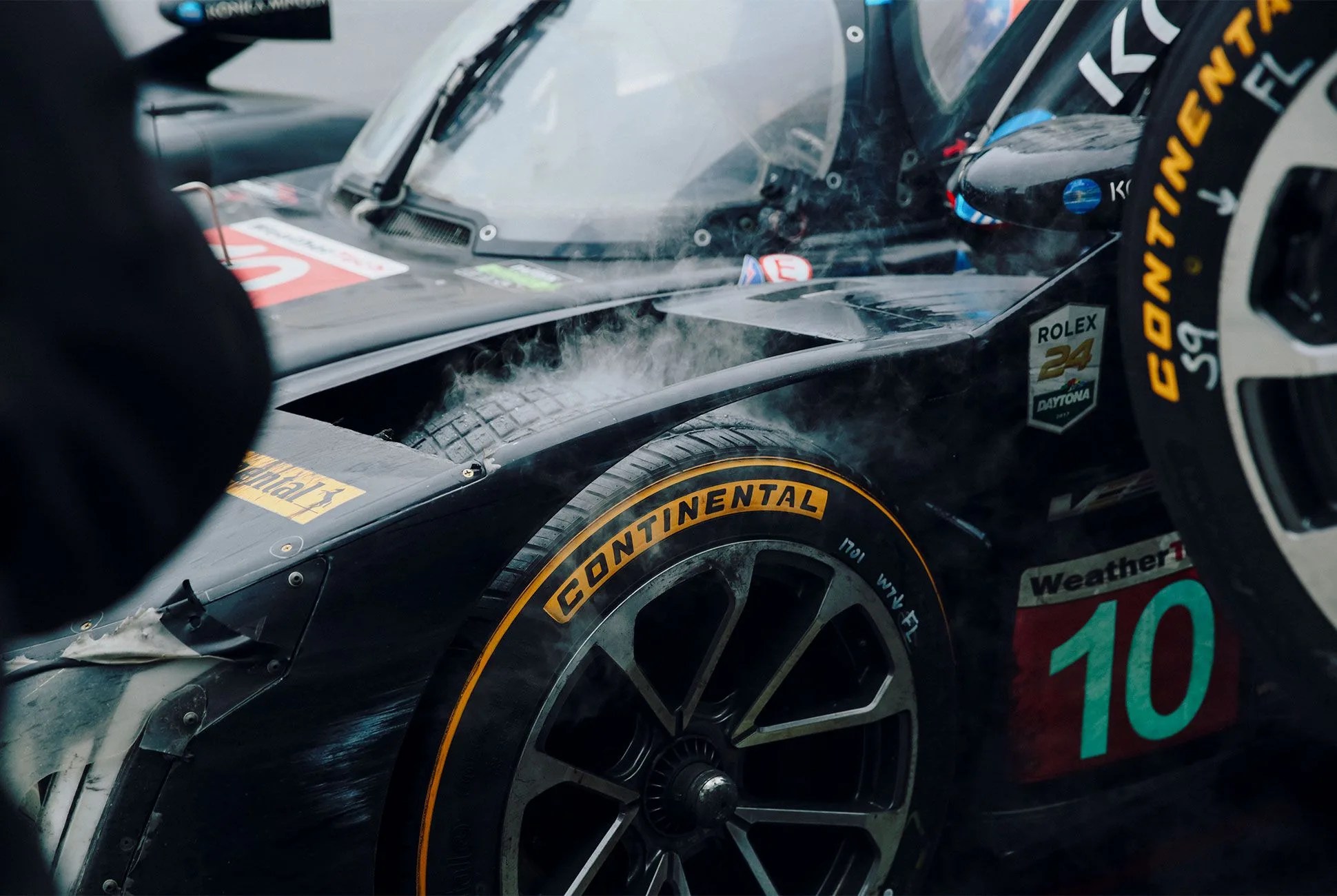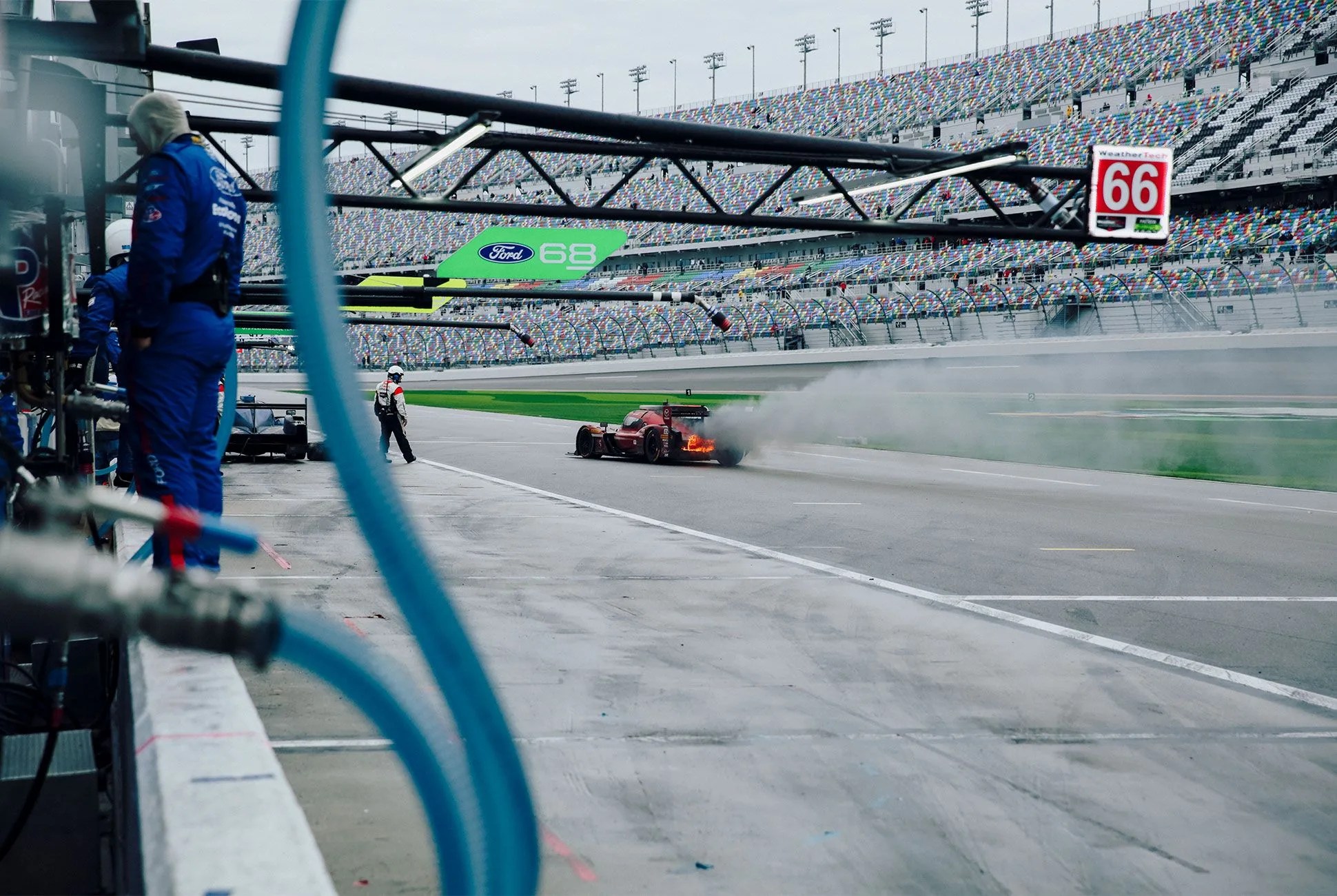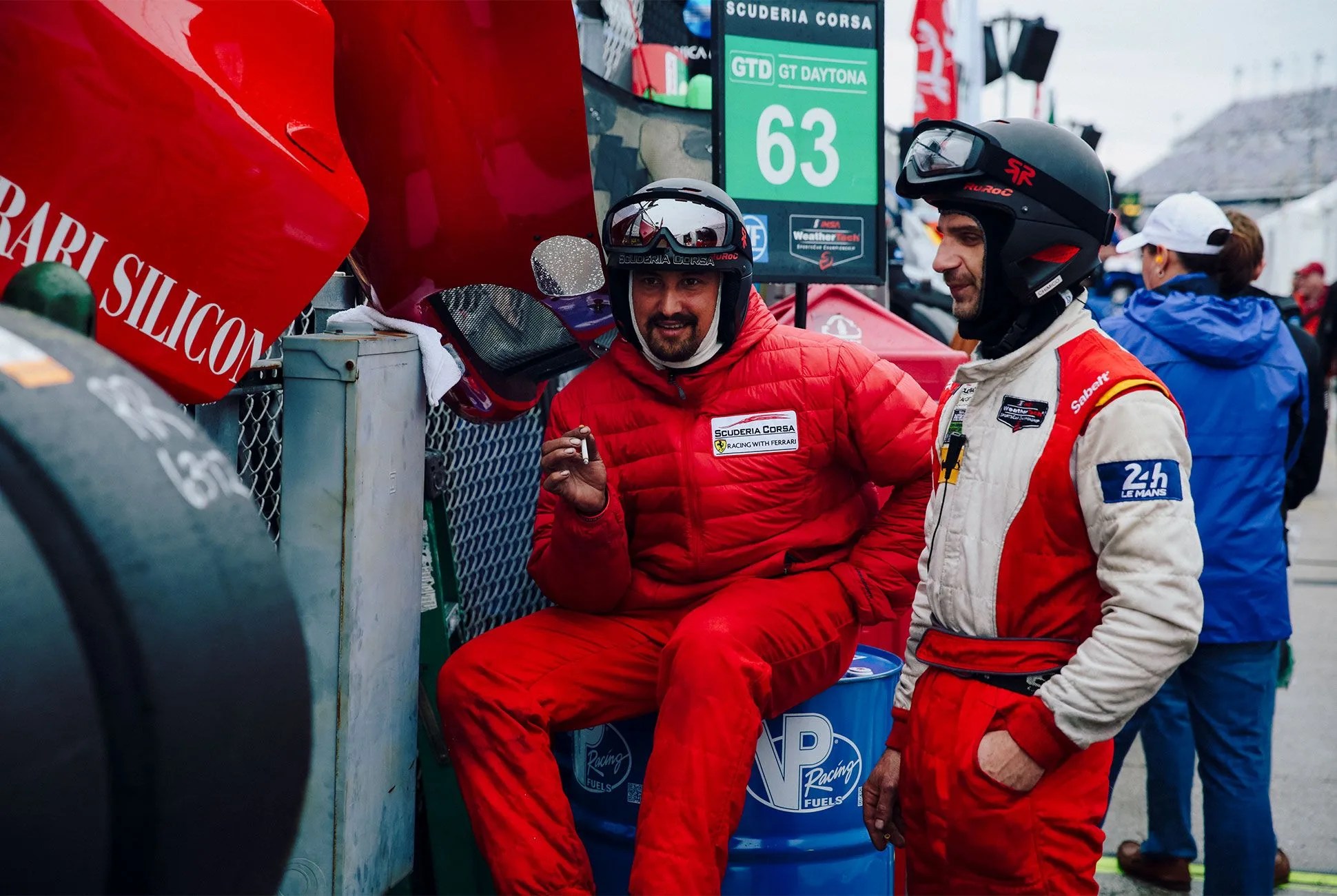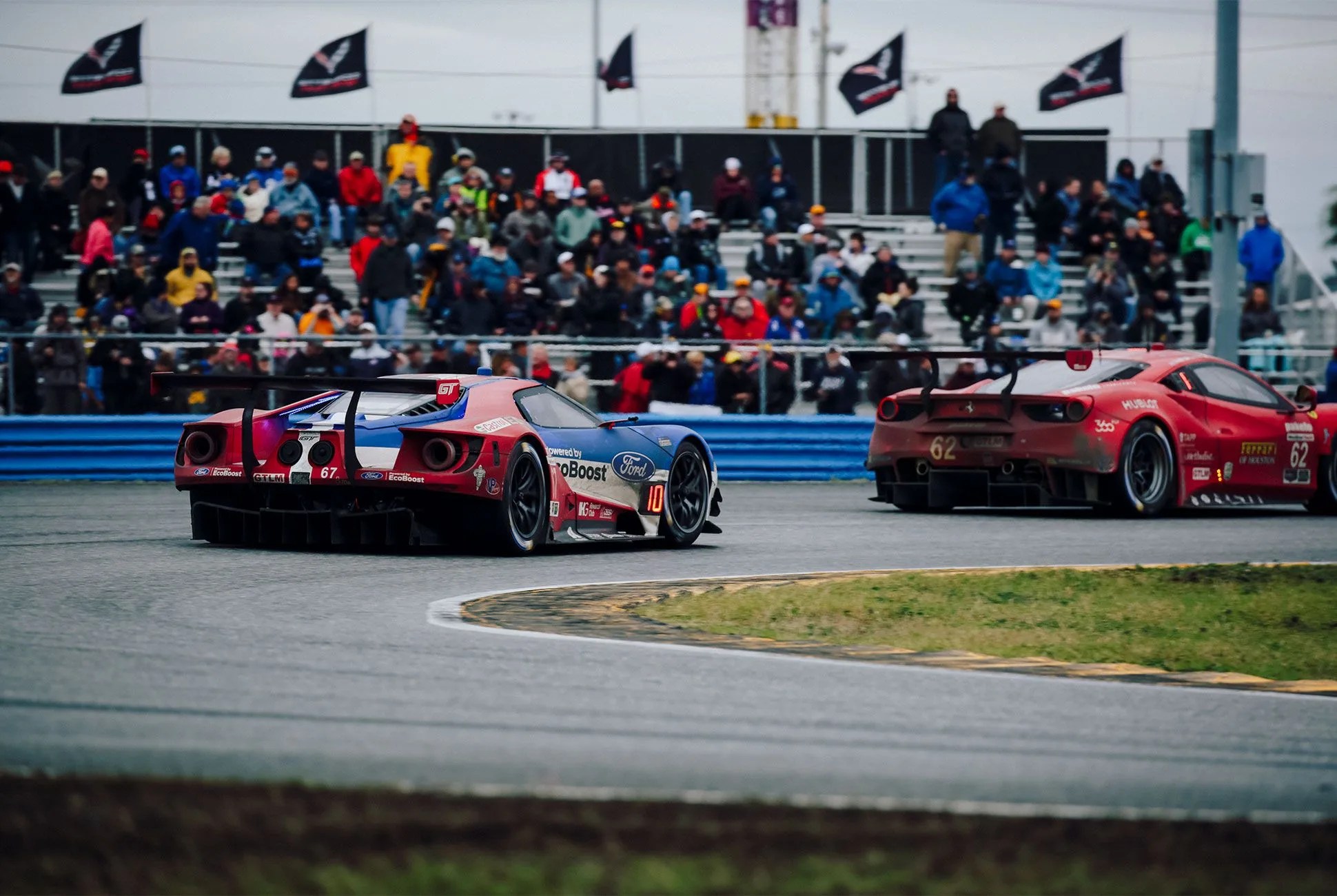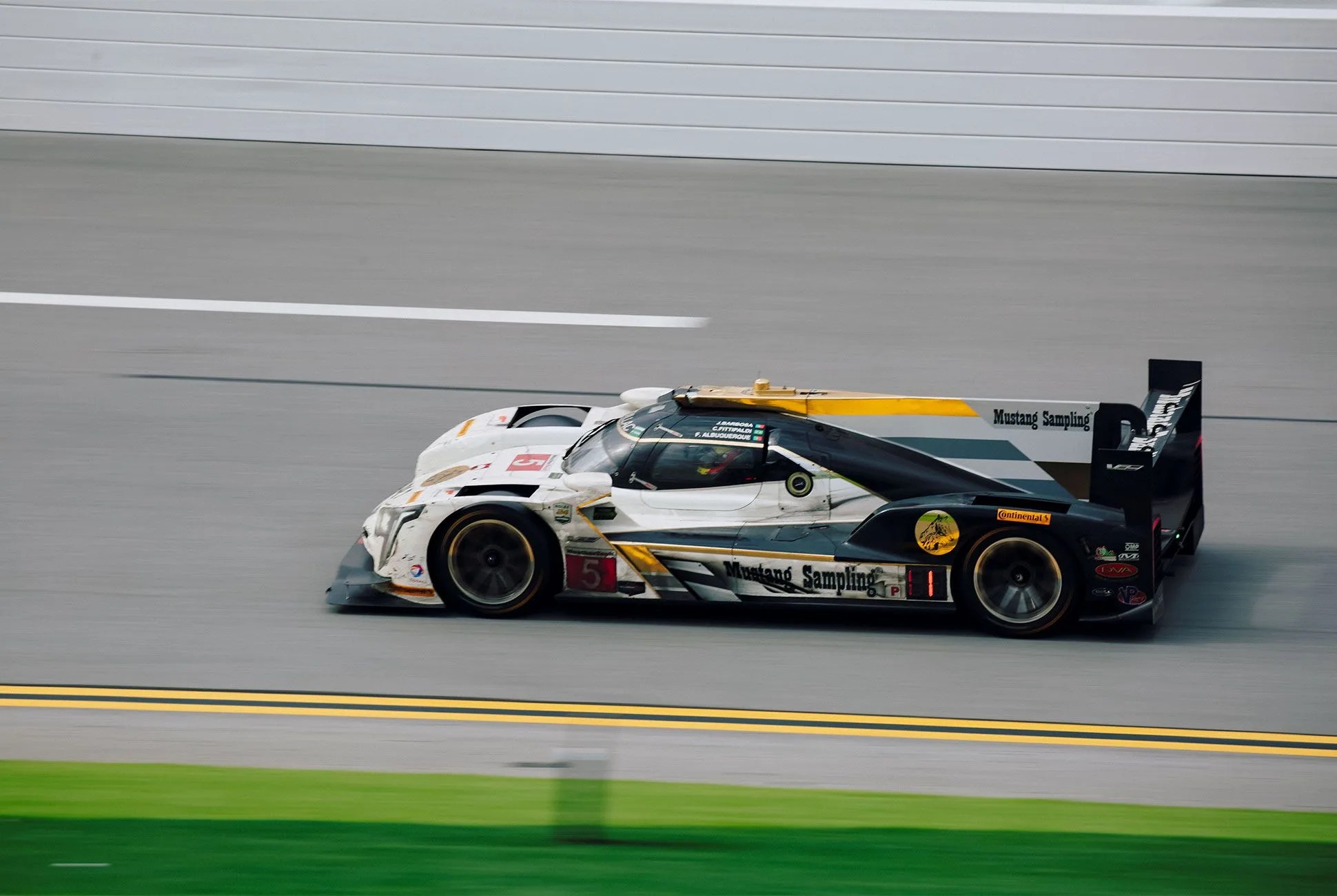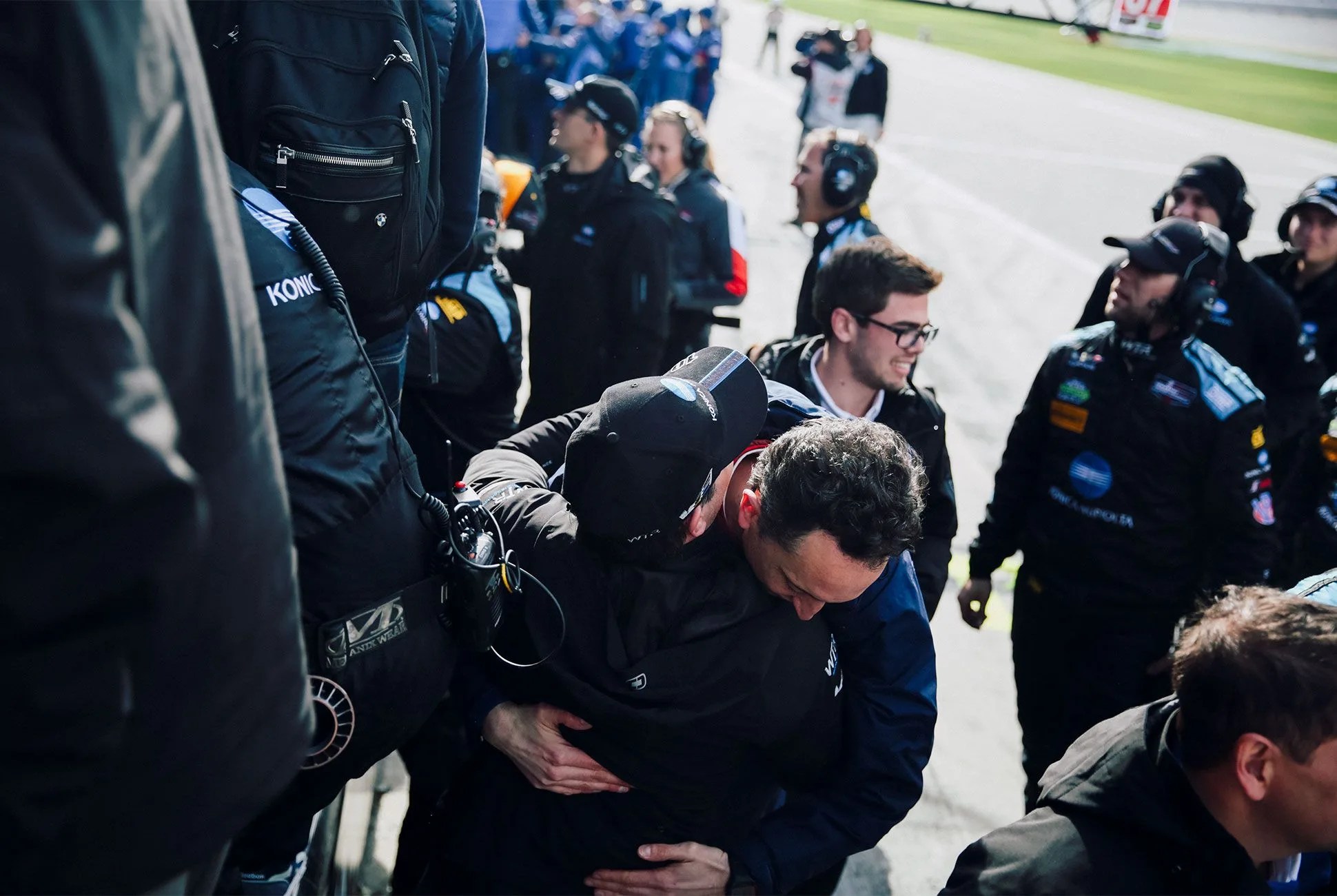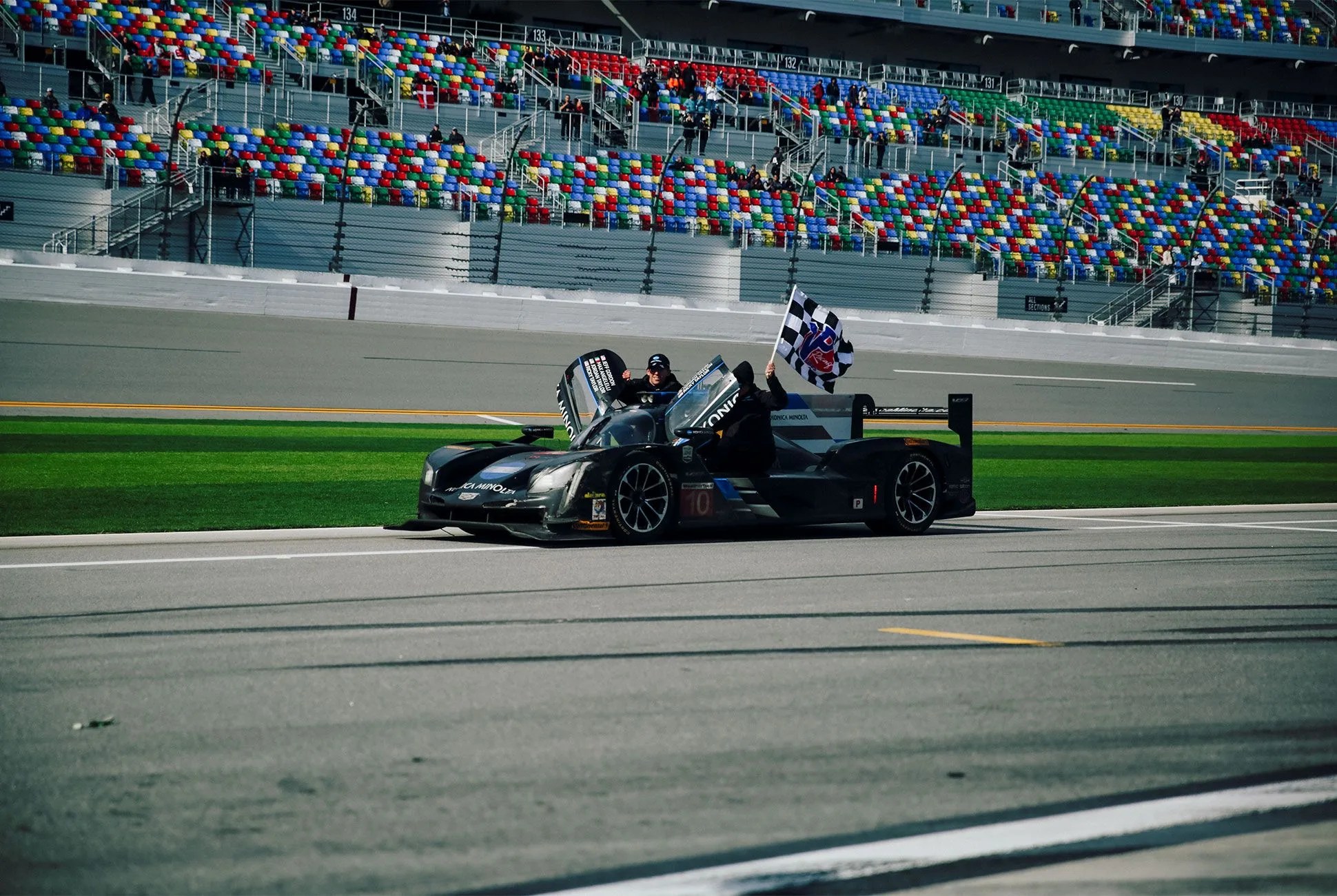From Issue Four of Gear Patrol Magazine.
Discounted domestic shipping + 15% off in the GP store for new subscribers.
Imagine if the Super Bowl were the first game of the season and, instead of the usual spectator-friendly, commercial-packed four-hour run time, it went for a full 24 hours straight — from coin toss to the final whistle blow. Hardly any players would last the whole game; the surviving players would hardly be unscathed. No matter how many multi-million-dollar 30-second commercials one might dangle in front of Roger Goodell, the NFL would never sign o on the idea. But that’s exactly how sports car racing in America kicks o each season — with a nonstop race that lasts two full trips around the clock. It’s a gauntlet that has been run for the past 51 years. It’s called the Rolex 24 Hours of Daytona, and it’s one of the toughest tests both man and machine can endure.
Up and down the Daytona grid, cars from brands you see every day — Cadillac, Porsche, Mazda, Mercedes-Benz, Ford, Ferrari, Chevrolet and Lamborghini — battle it out to prove who has the best product. Since the rules of the International Motor Sports Association (IMSA) dictate that competing cars must, with a few regulated modifications, share common architecture and internals with their road car equivalents, endurance racing is the clearest and most unbiased way for a company to see how its pride and joy stacks up. Lower classes of race cars are nearly identical to the production cars you might see on the street. Top classes, referred to as “prototype” classes, have incredibly aerodynamic, experimental bodywork, but are still required to use engines based on motors from street-legal production cars. Racing is how a car company puts its money where its mouth is; a victory at Daytona says more than any silver-tongued ad campaign could hope to. This is where that old adage, “win on Sunday, sell on Monday,” was born.
Coming into the 2017 IMSA season, Cadillac, in particular, was capturing all the headlines, having been absent from prototype racing since 2002. The brand could have chosen to race in the lower classes, but there’s more glory to be had in the top-flight Daytona Prototype International (DPi) Class, the all-or-nothing class that tends to win the 24 Hours of Daytona outright. So Cadillac went all-in and sourced the 640 horsepower 6.2-liter V8 from the CTS-V, the most powerful engine the brand has ever put on the road.
Originally built for day-to-day driving, the CTS-V sedan is designed to haul families and groceries during the week, then haul ass at the occasional weekend track day. It’s a relatively unassuming four-door sedan with an interior clad in leather, brushed aluminum, and splashes of suede and carbon fiber — a car with ample leg room in the back and usable trunk space. But give it a long enough stretch of road, and that supercharged V8 will move the 4,129-pound car to 60 mph in 3.7 seconds and top out at 200 mph — stats historically reserved for supercars from Ferrari or Porsche. Which is why the CTS-V’s V8 was the perfect candidate to power Cadillac’s DPi car, dubbed the DPi-V.R, for the 2017 race.
A victory at Daytona says more than any silver-tongued ad campaign could hope to.
Ironically, Cadillac needed to tone down the engine to about 600 horsepower in order to meet the IMSA’s regulations for the new DPi class. Along with regulated power output, 2017 DPi cars are governed by numerous new rules regarding their design and construction. DPi cars are basically highly aerodynamic carbon-fiber-framed and -bodied, mid-engined vehicles from Cadillac, Mazda and Nissan. Still, they must incorporate design cues from their respective road cars, and the engine underneath a DPi’s aggressive air-cutting bodywork is what’s most similar to its street-legal siblings. Putting production engines to the test is the cars’ reason for being: to help push each manufacturer’s engine technology to the limit, far beyond what a consumer might ever experience.
DPi-V.R driver Ricky Taylor said the engine gave the team a huge advantage. As in the real world, “In sports car racing there’s lots of different engines that do different things well. There’s turbo-powered cars, tiny little four-cylinders, and then there’s the big 6.2-liter V8 that we have,” he said. “Some of the other engines will take a while to build power and spool up but have a really good top speed. The strong point for us is how much torque the engine makes. So when you’re racing for twenty-four hours and there are slower cars you need to get by efficiently, we can get clear of them pretty quickly and safely with a little squirt of power between corners, whereas the other cars might have to out-brake them into corners and take more risks.”
Story Continues After Photos
8 photos
Those “other cars” include class competitors from Mazda and Nissan, both with know-how from recent seasons of IMSA prototype racing (remember, the last time Cadillac went racing at this level was in 2002). The brand saw the recent resetting of IMSA regulations as an opportunity to showcase and test their big V8, and subsequently put its 2017 DPi-V.R together from the ground up. But in endurance racing, a clean slate is not always a good thing. Inexperience is not often met with fortune; beginner’s luck tends to run out of gas after the first few hours. What Cadillac lacked in modern elite endurance racing experience, they compensated for with meticulously engineered machinery and an unparalleled cast of all-stars.
To hedge its bets, Cadillac enlisted two top-tier teams to run its engines: Action Express Racing, which was going to field two DPi-V.Rs, and Wayne Taylor Racing, which would field just one car and head to Daytona as the favorites to win.
Wayne Taylor himself raced Cadillac prototypes from 2000 to 2002 with regrettably unsuccessful results, which he refers to as “unfinished business.” Taylor has competed in the IMSA sports car series since 1989 and has won the 24 Hours of Daytona twice with GM backed cars (though not Cadillacs). In 2004, Taylor formed Wayne Taylor Racing and then eventually retired from professional driving in 2007. All the while, his team has kept close ties to GM, having raced Pontiacs or Corvettes for a number of years.
Race day, 2:30 p.m.: The race clock started, the green flag dropped and 55 cars filed into Turn One.
Taylor enlisted his sons Jordan and Ricky to help develop, tune, race and share driving duties in the new car. The third driver announced was Max Angelelli, who raced Cadillacs with Wayne Taylor back in 2002, and won the 24 Hours of Daytona in 2005, sharing a Pontiac race car, again with Wayne. Adding to the theater, Angelelli made it known that this year’s 24 Hours of Daytona would be his last before officially retiring as a full-time professional driver.
The final driver enlisted by Taylor: none other than American racing legend Jeff Gordon, who emerged from his own two- year retirement to copilot the new Cadillac DPi-V.R and headline the modern-day motorsport dream team.
Race day, 2:30 p.m.: The race clock started, the green flag dropped and 55 cars filed into Turn One. Over the course of the first 12 hours, day turned to night, the temperature dropped, rain fell and the rate of attrition rose steadily. The drivers in slower, less powerful classes were having a tough enough time just keeping their cars on the track and shiny side up. Ricky Taylor described racing in those atrocious conditions as “the hardest part, because if you don’t push, somebody else is going to push and it’s so easy to make a mistake. There’s nothing more di cult,” he added, “than going out in the dark on a freezing cold race track that’s wet, with a little over six hundred horsepower, and not making any mistakes.”
As the hour hand completed its final round-trip on the official Rolex race clock, the 24-hour endurance race rapidly morphed into an all-out sprint. In the final seven minutes, only tenths of a second separated Ricky Taylor and Filipe Albuquerque, the latter in the lead in one of the other two Cadillac DPi-V.Rs from the rival team Action Express Racing. With four laps left, Taylor and Albuquerque dive-bombed into Turn One at triple-digit speeds, side by side. Taylor cut to the left, muscled Albuquerque out of the way and made it stick — a buzzer beater in endurance racing. Four laps later, still barely in the lead, Taylor crossed the finish line just over half a second ahead of Albuquerque, securing his first ever win at Daytona and a tense one-two finish for Cadillac.
Story Continues After Photos
10 photos
To bring home such a monumental win takes more than just tenacity and race craft. “There’s so much preparation that goes into preparing a new car,” said Ricky. “And to kick it o with a twenty-four-hour race, the team had to work such long hours — eight in the morning till eight at night, every day.” But the human element is only a fraction of the winning formula; if the car doesn’t match the driver’s capabilities, a win will never be in the cards. According to Ricky, the massive Cadillac V8 was an irreplaceable boon. Citing the unequivocal need for “driveable power to get around the slower GT Class traffic,” he added: “With all that torque, we actually had a very drivable engine. It may be the same 6.2-liter V8 from the Escalade and CTS-V, but it really is something special [on the track].”
Considering the gladiatorial battles and precarious conditions the Taylor broth- ers, Angelelli and Gordon were enduring throughout the race, smooth and predictable power delivery was a must. Furthermore, for four different drivers, each with a different driving style, to swap in and out of the same car without pause for 24 hours straight, the V8 engine Cadillac bolted behind the driver’s seat had to be unbelievably compliant.
According to Cadillac Global Director of Product Strategy Richard Brekus, the adeptness of the engine is inherent in Cadillac’s general philosophy. “We’re all about competing, we’re all about winning,” said Brekus. Cadillac’s secret is ensuring engineers take turns building the CTS-Vs and wrenching on the brand’s race cars — a surefire way to get cross-pollination between the performance cars on the road and the all-out race cars on the track. “The engineers that work on all of our cars — what you’ll find is that a lot of them actually race on their own. They have their own race cars at home and they go racing in their spare time. It permeates the whole organization. Racing really is in our blood.” Translation: The engineers who know quite literally every nut and bolt of the production V8 in the CTS-V directly impact the high-endurance racing powerplant in the DPi-V.R that won Daytona.
Pistons need to be tougher, bolts need to be lighter, cylinder heads need to withstand enormous heat — and it all needs to last 24 hours of constant abuse, lest it succumb to the inherent half-life that motorsport inflicts upon machinery.
To help evolve and adapt the road-going V8 from the CTS-V to the onslaught of 24-hour at-the-limit racing, Cadillac worked closely with Earnhardt Childress Racing Engines (ECR) — a SEAL Team Six of motorsport engineering. “The engine architecture is inherently shared with the production CTS-V,” Matthew Wiles, director of engineering at ECR said. “It’s basically a racing version of the engine block, but in the [race car’s] case, the engine is a semi-stressed member and bears about fifty percent of the chassis loads.” This means, essentially, that to save weight and space and to increase strength, the race car’s suspension is bolted directly to the engine; the engine is then bolted to the carbon-fiber body frame. “The race engine has a significant amount of bespoke content, including custom hardware and reinforced materials,” Wiles said. That’s because for successful long distance racing, everything needs to be reinforced. Pistons need to be tougher, bolts need to be lighter, cylinder heads need to withstand enormous heat — and it all needs to last 24 hours of constant abuse, lest it succumb to the inherent half-life that motorsport inflicts upon machinery. There are differences from the road car’s engine, but at its core, Wiles said, the “overhead valve [and] pushrod engine architecture are the same as any production CTS-V on the road.”
Story Continues After Photos
19 photos
In the closing laps of the 2017 Rolex 24 Hours at Daytona, the entire Wayne Taylor Racing team was glued to the live race feed. If not for the constant outpour of more than 130 decibels from passing race cars, one could have heard a pin drop. That was the moment Ricky went for the pass on Albuquerque. The energy in the pit tent was electric, the emotion physical, reverberating in the air. The roar from the pit crew, team, family and friends briefly drowned out all 37 race cars left pounding around Daytona’s banked turns. Then, nervous silence, waiting, hoping, until four laps later, Ricky and his Cadillac crossed the finish line and took first place.
For Wayne Taylor, this victory isn’t just a professional accomplishment or career highlight; it’s a family moment. “It’s an unbelievable story,” he said. “Just talking about it makes the hair stand up on my arms. To bring the car to the first race, win the race and get in the car with the checkered flag, [Ricky] driving it down to victory lane and my other son Jordan jumping on the other side — I can’t think of anything that would be better than what we did there. Driving into victory lane was just overwhelming.”
For Wayne Taylor, it’s “unfinished business” that’s now been seen to.
And for Cadillac, the 2017 Rolex 24 Hours of Daytona wins mean more than just first and second place trophies. For Wayne Taylor, it’s “unfinished business” that’s now been seen to. Cadillac has undeniably emerged as a threat to the established German performance-luxury cars on the street and is back in motorsport demonstrating complete dominance over its rivals in America’s toughest endurance race.
The results Wayne Taylor Racing and Cadillac produced this year at Daytona required a million moving parts working in unison. Not the least were the transcendent skills of the drivers and mechanics who stayed sharp throughout the night despite freezing temperatures, treacherous rain and inevitable exhaustion. But even the drivers and teams will say the key-stone of Cadillac’s success at Daytona was the race-ready nature of the CTS-V V8 — a race-proven engine purpose-built to win on Sunday and then navigate the real world any given Monday.
Read More in Gear Patrol Magazine

A version of this story appears in Gear Patrol Magazine: Issue Four, 320 pages of stories, reports, interviews and original photography across America. Now available. Subscribe Now: $39
